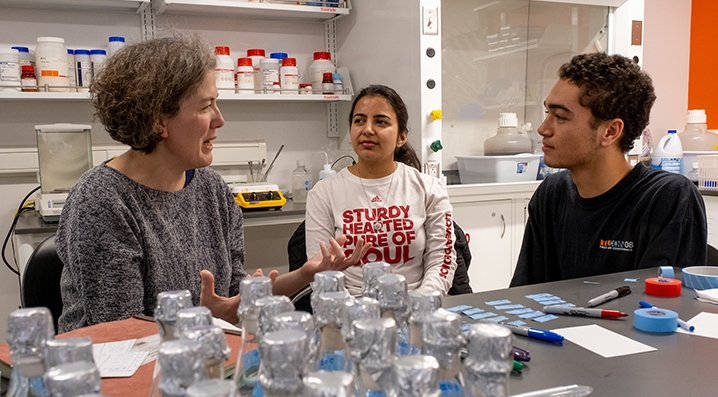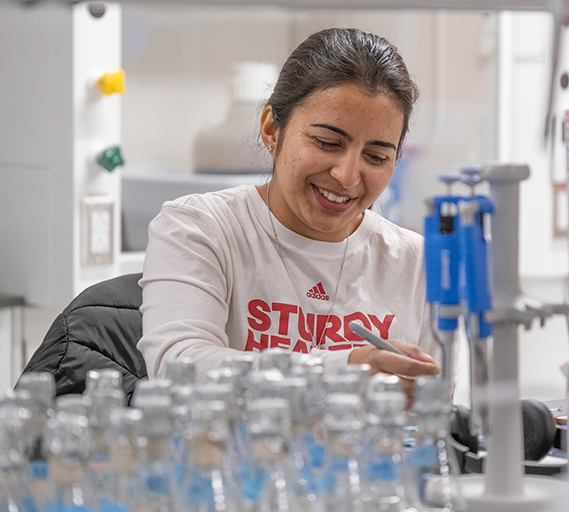
Microbial "neighbors" improve ammonia removal in wastewater
By Susan Meikle, university news and communications. Part 3 of a four-part series on new grants for the new microbiology physiology cluster.

Annette Bollmann (left), doctoral student Sabita Ghimire and sophomore microbiology major Matty Weaver (photos by Scott Kissell).
In nature, diverse microorganisms coexist and interact in complex ways. Communities of different microorganisms can perform vital functions more efficiently than single species achieve alone.
One group of microorganisms — ammonia oxidizing bacteria (AOB) — oxidize ammonium to nitrite and play a key role in the removal of ammonium from human-derived urea in wastewater treatment plants.
Ammonia is converted more efficiently when the AOB are in a microbial community than when the oxidizing bacteria are alone, according to Annette Bollmann, associate professor of microbiology.
But the interactions among microbial "neighbors" that improve ammonia conversion are not well understood, Bollmann said.
She recently received a $368,066 grant from the National Science Foundation (NSF) to better understand how ammonia removal in wastewater by AOB is improved by a diverse community of neighbor microorganisms.
In laboratory settings, most studies focus on microorganisms in pure cultures. Bollmann and her research group are interested in interactions of diverse microorganisms, the mode of interactions and how these interactions benefit or harm the microbes in the environment.
Using freshwater samples from Acton Lake in Oxford and from Lake Superior, Lake Erie and other lakes, Bollmann and her research group are studying similarities and differences in AOB grown in laboratory pure cultures, in laboratory enrichment cultures and in their original environments.
- This research aims to increase the ability to manipulate microbial communities to function more efficiently, such as those in wastewater plants to improve ammonia removal.
- Another goal of this project is to educate a wide range of students on the importance of microbial communities and to raise awareness and urgency about water quality.

Ghimire works in Bollmann's lab in the newly-renovated Pearson Hall.
Outreach programs
Rebecca Balish, senior lecturer in microbiology, and Bollmann are creating outreach programs for:
- Fourth-graders at Kramer Elementary School in Oxford, to learn about microbial communities, nitrification and eutrophication — a leading cause of damage to many freshwater and coastal marine systems.
- Miami University students in the non-majors lab course “Experimenting with microbes,” to learn about fresh water and AOB-ammonia oxidizing bacteria.
- Local first- through fourth-graders who attend Miami’s Science Week, an annual event for students from Kramer, Bogan and Marshall elementary schools. Miami faculty, staff, graduate and undergraduate students provide hands-on learning experiences in the sciences and engineering.
Bollmann’s graduate students:
- Doctoral student Sabita Ghimire.
- Master’s student Austin Grant (co-advised with Xin Wang).
Four undergraduate researchers currently work with Bollmann:
Callihan Clayton, junior biology major and premedical studies co-major.
Conor Dolson, senior microbiology major and premedical studies co-major.
Chloe Moncayo, junior Spanish and microbiology double major.
Matty Weaver, sophomore microbiology and premedical studies co-major.
